1981: Our Intrepid Team Takes on America’s Other 24-Hour Race . . . and Wins!
Our 924 is running and handling beautifully. I’m shifting at 6000 rpm, well before redline, going easy on the brakes, using all of the road but no more, careful not to drop any wheels off the asphalt. I don’t want to shock-load the suspension or risk slicing the sidewall of a tire.
Our crew gives me lap times over the radio. I work down to 1:30s for the two-mile course, a couple of seconds off my best in practice, getting back to endurance-racing rhythm.

It takes a few laps to get acclimated to the dark, and I can’t see as well as in last night’s practice because one of our cornering lights is out . . . the one that shows the outsides of right-hand corners, and Nelson Ledges’ fastest curves are rights—Turns 1 and 3, which are not quite flat-out, and Turn 11 (the back-straight “kink”) which is.
Foot to the floor out of 13, upshift to second, third, then fourth gear down the start-finish straight.
Lift momentarily for the fast, right-hand Turn 1, turn in at the far left edge, back on the gas, brush the far-right apex, drift back to the outside left at 2; back on the gas, lift, feather the throttle easing right, exiting left again for 3, back on the gas again.
Brake and downshift for the left-hand Turns 4 and 5, on the gas, apex left, accelerate, then lift and feather entering the seemingly endless Turn 6-7-8 right-hand sweeping “Carousel,” holding a line roughly mid-track, deftly dodging a couple of jagged potholes that have opened up in Nelson’s aging asphalt during the night.
Full on the gas to apex far right through 9, drift to the outside left, upshift, foot to the floor, upshift, jog slight-right at 10, still flat, over 100 mph in fifth gear down the long back straight, line up far left for the hold-your-breath, no-lift Turn 11 right-hand kink, apex right, drift left to the outside edge, then brake and double downshift for the slow, left-hand 12; brake, downshift again for the right-hand hairpin 13; then foot to the floor past the pits.
Driving lights from cars behind are laser-bright in my mirrors. Passing slower cars is little problem, since I pull away quickly, but staying ahead of quicker competitors is tough.
I catch a Mazda RX-7 and pass it. Damn, his lights are bright! He dogs my bumper, trying to re-pass. His lights are searing my eyes. I turn the mirrors away but still have trouble seeing, making little mistakes, losing time. So, I let him by. Better to bother him for a while. But now he’s going slower than my pace, in my way. Our crew reports lap times in the 1:32s.
A faster car comes up from behind. I let him pass. It’s the #11 Porsche. Then another. It’s Hurley Haywood’s #58 Brumos Porsche. Behind him are a bunch more: the #55 Datsun Z, the #15 Datsun Turbo, the #33 turbo Mazda. The only one that really matters is #55 because he’s in the lead, a couple laps ahead of us. Maybe I can race with him, maybe not, but not now, in the middle of the night, in heavy traffic, when I’m tired and not functioning 100 percent.

I let them pass. They make short work of the RX-7, leaving him in my way again. Damn, those guys are racing hard! Two and three abreast, drifting and sliding, scraping paint, wheels in the dirt. Great fun to watch from just behind but seems foolish. Better to take no chances at this stage of the race.
I pass the damned RX-7 again, determined to get away from him, but he sticks to my tail like a trailer. Obviously, he functions better without my lights in his mirrors. Finally, he pits. Clear ahead and behind. I start feeling better, driving better. The car is still running like new. The brakes have faded a bit, but a pull on the handbrake brings the pedal back to normal.
Is there a vibration in the left front? No, guess not. Wait—there it is again, a little feeling coming up through the steering wheel in fast right turns . . . a feeling that’s disturbingly familiar. I felt the same thing in Carlos Ramirez’ Herman+Miller 924 in the previous year’s Longest Day, and it turned out to be a bad wheel bearing that ultimately failed catastrophically.
“How fast can you change a front wheel bearing?” I ask the crew over the radio. They wake up team leader and lead driver Freddy Baker, who had just gotten to sleep. We decide to stay out until the next scheduled stop, an hour away. The bearing on last year’s Ramirez car lasted through my driving stint and the next two before letting go. But this one is getting worse—fast. In 15 minutes, it’s howling in right turns. In another 15, it’s howling all the time. We decide to bring the car in, a half-hour early.
I head for the pits as soon as the crew is ready, loosening the belts and popping the hood as I brake to a stop. The left side goes up as I’m scrambling out. Off come both wheels. Everything is laid out neatly. Crew chief Eric Steinel tears into the left front while a crewman tackles the rear brakes and two others refuel. I steady the car while they work and communicate what I can about its condition and the track’s to co-driver Bob Nikel, who is ready to relieve me.
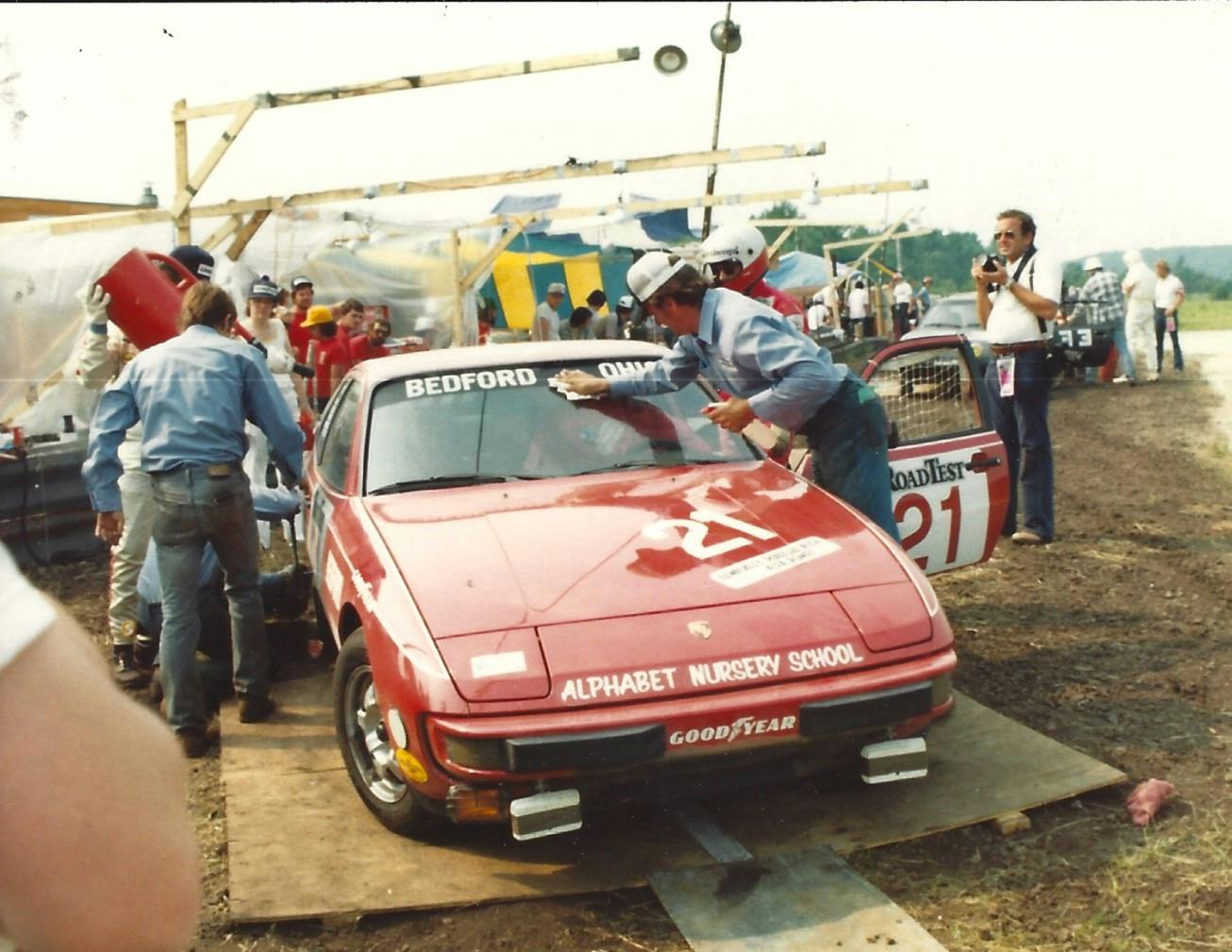
Fueling done, the crew hurries through routine checks, cleans the windshield and changes the air filter element while Nikel jumps into the car and starts belting up. Down goes the left side, up goes the right. Steinel and his crew are running around like madmen. Then the car’s off the jacks and ready. So is Bob, and off he goes into the night. With just four crewmen (the maximum allowed), they had changed the left front wheel bearing, brake pads, hub and rotor, both rear brakes and three of our four Goodyear tires, in addition to refueling and running through normal pit-stop procedures, in 11 minutes and 52 seconds! Amazing!
It’s now 5:30 a.m. I go to the motorhome, peel off my sweat-soaked driver’s suit and try to sleep. It’s hot and muggy. I listen to the sound of squealing tires around the track. Five hours before I’ll drive again, I can’t take my mind off the race. It’s starting to get light outside . . .
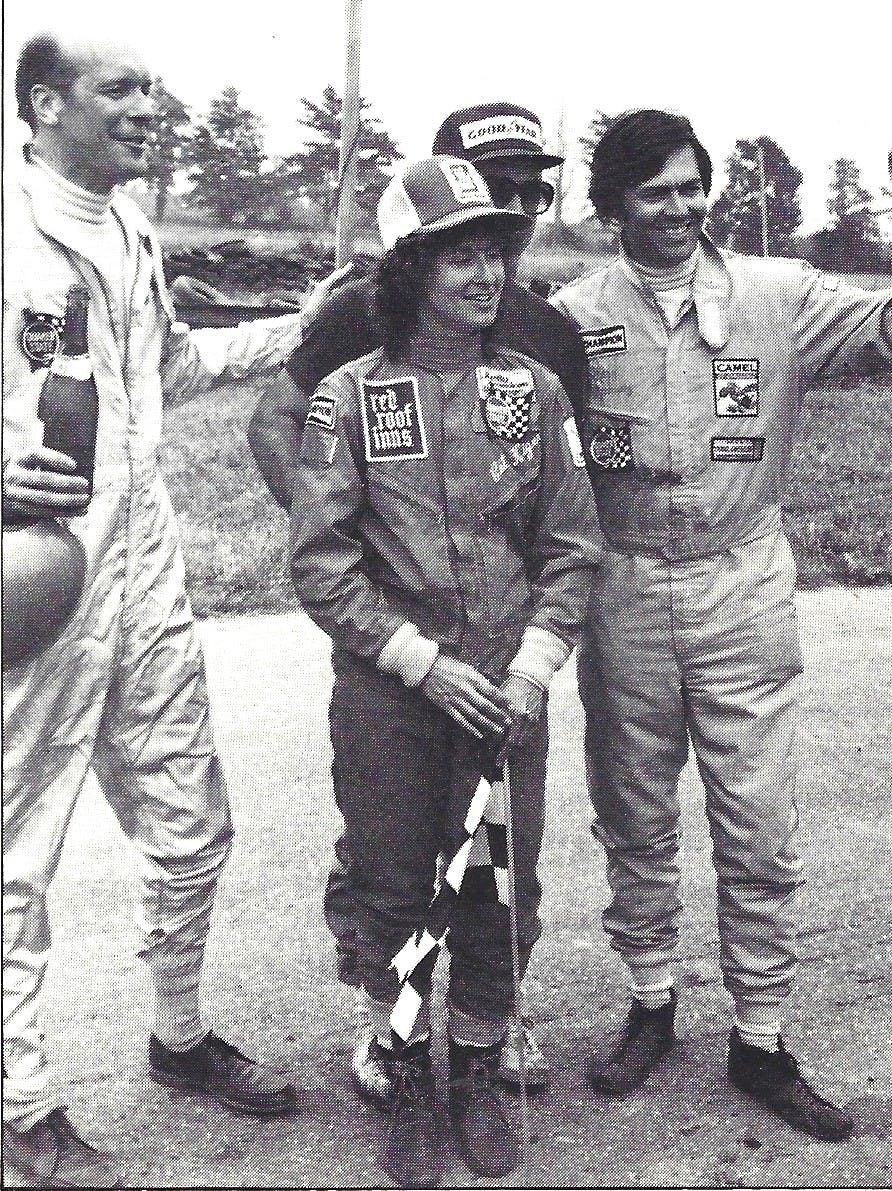
Second Annual “Longest Day”
As those who have read my 1980 “Longest Day” story will recall, this madness began when the slightly crazed folks who run the old Nelson Ledges track near Warren, Ohio, decided to stage a 24-hour race for SCCA Showroom Stock cars. At the time, it was the country’s only twice-around-the-clock race besides the famed 24 Hours of Daytona.
That first year I had co-driven Carlos Ramirez’s Herman+Miller 924—which started on the pole and led early but succumbed to multiple problems—and SCCA national champion Freddy Baker called to ask if I’d like to team with him for the 1981 event in a 924 sponsored by his Porsche+Audi Motors of Bedford, Ohio. He also lined up Catherine (Cat) Kaiser, SCCA’s first and only (at the time) female national champion, and friend Nikel, a Sewickley, Pennsylvania, Porsche dealer and excellent driver, to co-drive. I scored some support from (now long defunct) Road Test magazine to take on cars backed by Car and Driver, Road & Track, and Motor Trend.

That first “Longest Day”—so called because it was run on the summer solstice, the longest day of the year—had attracted a surprisingly good field of amateur racers and a few factory-assisted efforts, including the works Saab team with the 900 Turbo that ultimately won.
The event had grown in interest and stature in its second year, drawing several factory-supported efforts and quite a few pro and top amateur drivers. Among the entries in a new “Prototype” class for modified cars (not Showroom Stock legal) were a turbocharged Mazda RX-7 and a matched set of factory Datsun 280ZX Turbos. Can-Am series class champion Tim Evans would be in the turbo RX-7 and endurance ace Hurley Haywood, one of America’s best pro road racers, would co-drive a works Brumos Porsche 924. Other notables included IMSA champ Walt Bohren in a semi-works RX-7 with top pro rallyist Rod Millen and Showroom Stock champion Ron Christensen; former Formula 1 driver Innes Ireland joined the previous year’s winning Saab team; and Indy driver Tom Bagley was in a Triumph TR-7. In total, four past SCCA national champs (including our Baker and Kizer) were entered, and there were several good racing writers and even one TV star (and amateur racer), Kent McCord, in an RX-7.
Why? For the fun, the challenge, and (for factory brands) the PR glory of it. Not for the $7900 purse, more than two-thirds of which was contingency money generously offered by Quaker State Oil.
Back to the Race

Things had gone well in Friday’s practice. All four of us got down to competitive times without abusing the car. I did most of the night testing to help aim the lights, then everyone else got a turn to get used to running in the dark. Baker qualified us third at 1:27.29, just behind the #11 924 at 1:26.24 and the #55 Datsun at 1:27.21, but ahead of Haywood’s 924.
The green flag fell at 3:02 p.m. Saturday, June 19. Thirty-four gas pedals slammed the floor, and 34 Showroom Stock racers buzzed and squealed (SS cars run mufflers and street tires) into Turn 1. Burrell led the first lap in the #55 Datsun, and Baker came around in second. Haywood passed Baker in Turn 12, Baker countered on the inside into 13, and they were neck-and-neck down the straight. The race went on among these top three until Baker grabbed the lead and kept it on lap five. Haywood was second, Burrell third.
A few laps later, Haywood’s car stopped on the back straight with an electrical problem. A tow truck went out to retrieve him (allowed and encouraged under Longest Day rules), and then he got hit from behind while being towed. The once-beautiful Brumos Porsche, its left rear crushed, finally arrived in the pits on a rope, and its crew went to work.
Burrell passed us (illegally under the yellow flag) for the lead, and Baker backed off to save the car. Haywood was back out with the damage hastily repaired, then in again with his car’s rear hatch flapping in the wind. The Saab Turbo was already smoking from troubles that would soon put it out. Baker ran an hour and 50 minutes before pitting for fuel, then Kizer took over. Our stop was a mediocre 2:47 compared to 2:00 for the leading Datsun. We had to get better.
Kizer radioed: “Intermittent clicking while cornering on bumps, sounds like the steering box.” Our eyebrows furrowed, but it didn’t get worse. Fred said to listen for it during my stint. The #11 Porsche came in with a ruined front tire and a missing sway bar bushing and lost several laps fixing it. The Brumos car’s hatch was loose again. A couple of cars had gone off into tire walls. “Yellow flags all over the place, oil and glass on the track,” Kizer reported.
Back in Control

I take over four hours in, about 7 p.m, and drive uneventfully to dusk. My biggest problem is staying put in the stock seat. My left shoulder gets sore from bracing against the door in fast right turns. But no one passes me. We’re now running third behind the #15 and #55 Datsuns. I pit and hand over to Nikel just before 9 o’clock. Our stop is a quick two minutes.
A TR-7 is towed in looking like it had been stepped on by an elephant. It had gone off and rolled in the infamous Carousel. We’re in and out of the lead by 10 p.m. as we alternate pit stops with the Datsuns. We lose the lead when Nikel pits and hands over to Baker. An hour later, we get it back when #55 pits. The fourth-place #14 Turbo ZX is out with a failed left-front wheel bearing that takes out its left-front brake. Nelson Ledges’ long, bumpy, high-g right turns are (as always) chewing up wheel bearings like popcorn. The mangled TR-7 is back on course, still running. The #11 Porsche is in again with a rear stub axle issue, a victim of the Ledges’ bumps.

We’re worried about our rear brakes. They’re almost gone when I go out again, but we decide not to change them until after the midway point at 3 a.m. Baker reports that the seat is jammed full back. He’s having trouble reaching the pedals—but still doing 1:29s and 1:30s. We discuss having me drive next instead of Kizer, since my legs are longer than hers. But the crew fixes it quickly, and she takes over.
Suddenly, we hear that the track is out of fuel. I run to the Brumos truck, borrow an empty 55-gallon drum, roll it back and start looking for a pickup truck ride to the nearest town to get it filled. The track sells us enough for our next fill-up from an auxiliary tank they keep for farm machinery. (You don’t need exotic gas for Showroom Stock, fortunately.) They say a tanker is due at any minute. Eventually, it shows up.
Kizer radios that she’s not very comfortable racing at night, but she’s doing fine. At one point she goes inside another car to pass, and it pulls over and crunches our left front. “Guess we got each other,” she reports calmly.
Following our middle-of-the-night wheel-bearing stop, I get three hours of fitful sleep and awaken to learn that we’re leading, 49 laps ahead of the next SSA car, the #12 RX-7. The #55 Datsun, which had been giving us trouble all night, had succumbed to wheel bearing failure just after I’d fallen asleep. The prototype turbo Mazda is second overall, four laps back; an SSB BMW 320i is third.
I slide back into my driver’s suit and have some toast and coffee, trying to clear my head in time to relieve Kizer around 10:30 a.m. Suddenly, a crewman runs up and says I’m needed in the pits. I grab my gloves and helmet and sprint across the paddock. By the time I arrive, the emergency is over. Kizer had pitted unexpectedly with a contact lens out of place, fixed it, and took off again with little time lost.

I take over on schedule and settle into a fairly conservative pace in the 1:29s and 1:30s. We’re 50 laps up on the SSA RX-7 and should have a class win for sure . . . if we don’t break or crash. But Can-Am driver Tim Evans is going very fast in the turbo Mazda prototype, trying to make up a five-lap deficit for the overall lead. Another lethal pothole has opened up in the Carousel, making driving it doubly difficult. I’m trying to go fast enough to hold off Evans, yet slow enough to preserve the car—and our gas, because we’d like to make just one more stop—and I’m extra careful passing slower cars. He’s going a couple seconds a lap faster, but we figure his fuel consumption will force an extra stop.
Evans catches me, and I can’t hold him off. With much more power, he rockets past on the main straight. I try to hang onto his tail for a while but can’t without abusing the car. Eventually, he pulls away, and we’ve lost one lap. At one point, I come up behind two slower cars exiting the Turn 13 hairpin. I move right to pass, but one also moves right, obviously not seeing me, and I end up squeezing between him and the pit rail with two wheels in the grass.
Our rate of fuel consumption seems surprisingly good. Is the gauge stuck? Baker keeps asking about it over the radio. I keep telling him it’s okay. Evans appears in my mirrors again. Man, he’s flying! He passes again, and again I can’t stay with him. I’ve been out for two hours, and the gas gauge is reading just below a quarter tank. Normally it would be empty by now. I must be driving efficiently, but Baker’s getting more and more nervous. The #11 Porsche is in the pit next to us for fuel and repairs. We decide to wait until it’s out of our way.
Evans comes up and passes again; but we haven’t lost another lap since he’s been in for gas. Now the low-fuel warning light is blinking in right turns. The other Porsche is still in his pit, in our way. Baker says stay out until the warning light stays on. I’ve been driving almost two-and-a-half hours. No one has passed me except Evans, but he’s done it three times! Finally, the fuel light quits flickering and glows bright orange. We have to bring it in. As I’m completing a final lap, the other Porsche gets underway at last.
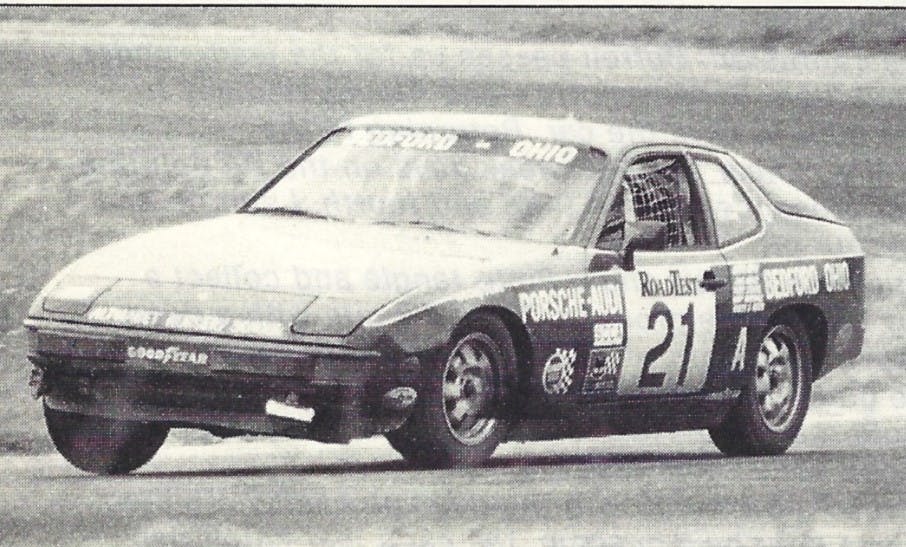
Our weary crew performs another flawless stop, and Nikel pulls away. I check the 22nd-hour standings and find the turbo Mazda still five laps behind. They’re leaving rocket-man Evans in for the final two hours but must be refueling twice as often as we are. We relax a bit, realizing they’re not going to catch us no matter how fast he drives.
With a bit over an hour to go, Evans streaks past Nikel on the main straight. His crew, gathered on the pit rail, cheers with excitement. We’re four laps up and, barring catastrophe, know we have this race won, so we join them in cheering him on. The fourth-running BMW that was handily leading SSB has expired with a spun engine bearing.
About a half hour from the end, we debate putting Baker in the car for the final laps. We would also like more fuel in the car, just in case. But what if something goes wrong—the engine won’t restart or we spill fuel and have a fire? What if the scorers discover they’ve made a mistake and we’re not really four laps up and end up losing the race after an unnecessary stop? Better to leave Nikel in and well enough alone. You get very paranoid toward the end of a long race, especially when you’re winning.

Finally, after a day and a night and a day of racing, it’s 3 o’clock again. The last lap! Sweaty, grimy, burnt-out crewmembers, drivers, family, and friends are jammed along the pit wall, cheering survivors as they pass. Here comes Nikel and . . . no checkered flag! Oh, yeah—the race had started at 3:02 p.m. One more lap, then, maybe two. A few crippled cars, after waiting for hours, are back out for the finish, creeping and smoking around for one last lap. One slowly clanks its way past the pits, trailing shredded engine parts, its block perforated by a connecting rod. It gets halfway to the pit straight bridge and dies in a pool of oil. Everyone is checking their watches. It’s got to be over next time around.
Here comes Nikel again, picking his way through this slow traffic. Every head turns to the starter’s tower. The stripe-shirted official checks his watch, confers with colleagues, picks up his checkered flag and waves it as our Porsche flashes by. Our team erupts into pandemonium. We’ve done it!
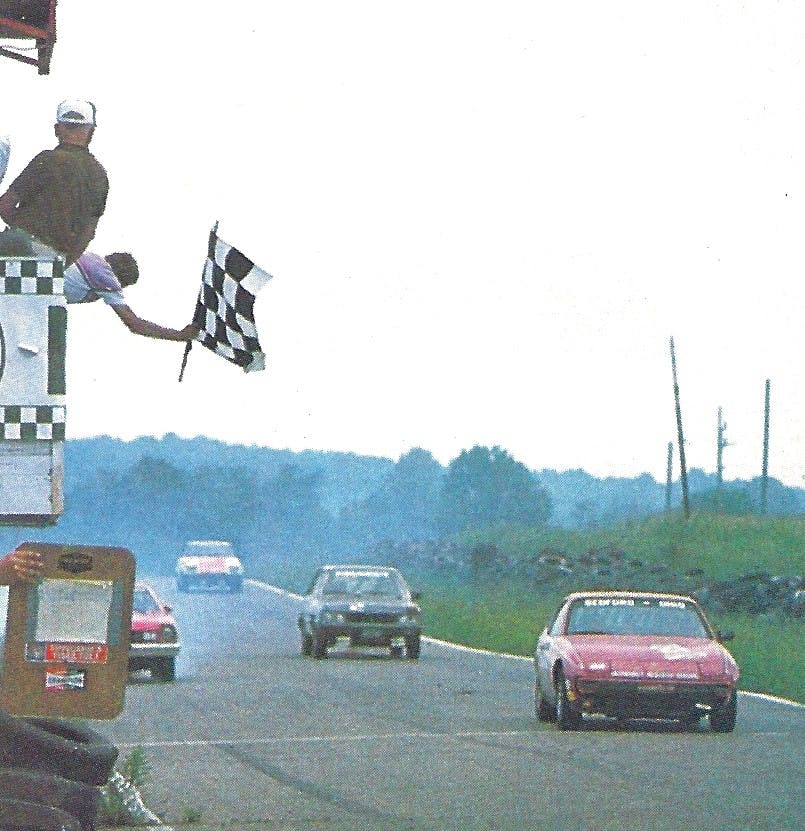

Nikel takes a cool-off lap and cruises in. Everyone crowds around, cheering and applauding. Someone hands us little checkered flags. The officials say only drivers can ride on the victory lap, so I slide into the passenger’s seat while Baker and Kizer crawl into the back, under the hatch. Nikel drives a little crazy around the track, nearly spilling Baker and Kizer, to cheers and applause from exhausted corner workers and spectators. We wave our little flags and grin stupidly, soaking it up.
This is what racing is all about, why people endure the tiresome travel, awesome expense, and long, wearing hours working on their cars. Just finishing this event is a victory, but winning is euphoria. We pose for photographers and smile politely through interviews, forgetting our bone-numbing exhaustion and the work still ahead of loading up for the long drive home.
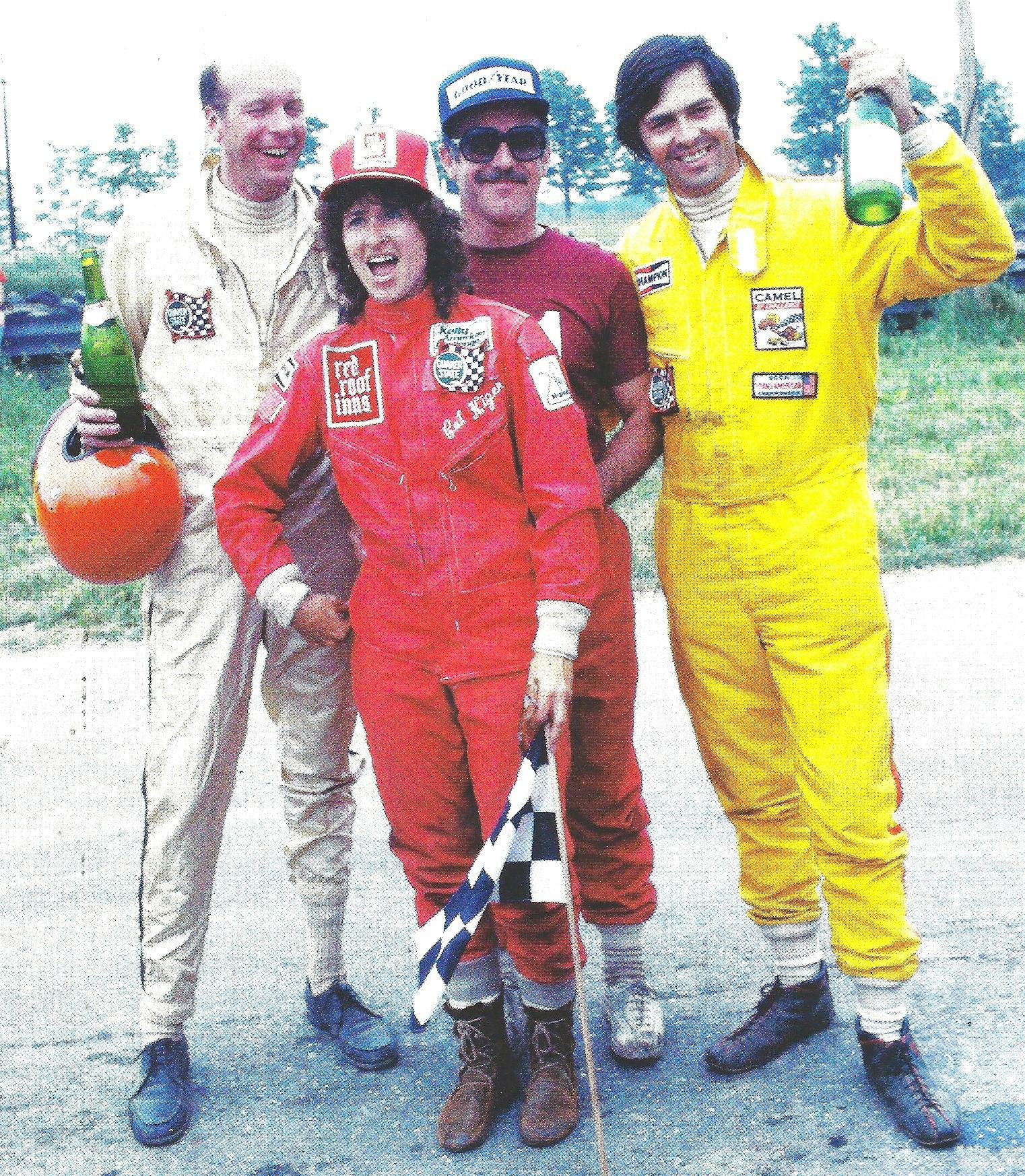
They hand Baker a huge trophy, which he’ll put in the shop for his crew. (He already has rooms full of trophies.) The broken BMW has somehow won its SSB class, a tough little Fiat X1/9 has won SSC, and that amazing turbo Mazda is second overall and first Prototype. In all, 23 of 34 starters have finished the race. Everyone has a story, but ours is best.




Love the story, always entertaining. One possible correction. As far as Kizer being the first and only female SCCA National champion at the time…I’m sure there are others too, but my neighbor Billie Erxleben won two SCCA National championships in the mid 1970s in a 240Z and a Triumph, I believe. Great drivers, but not sure about the first/only/female crown. BTW, love the 924. I had a 944 and my brother had two 924s. Great cars. Great Story. Cheers.
Matt,
Good question. Based on this story (https://racer.com/2020/03/10/the-better-half/), Donna Mae Mimms was the first female SCCA National Road Racing Champion in 1963, but she won the H-Production title that year based on season points. Cat Kizer was first woman to win an SCCA championship (also H-Production) by winning a season-ending National Championship “Run-Offs” race. No mention here of your talented neighbor Billie, but maybe she won championships in some form of the sport other than SCCA road racing. I was also very privileged to co-drive the Nurburgring 24-Hour with another great woman driver, Lyn St. James in 1979, before her Indycar and IMSA GT accomplishments: https://www.hagerty.com/media/motorsports/i-raced-the-79-nurburgring-24-hours-in-an-amc-on-street-tires/.
Great read! It is amazing how relatively primtively-prepared racecars could once be. Stock seats?! That alone would be incredibly tiring.
This flashed me back to the Chumpcar 25 hr 25 min 25 sec “world’s longest race” that I won with the Duct Tape Motorsports team in an E30 318is. It was a special feeling, for sure!
Wonderful piece! Thank you. The sublime grandness of Motorsport nicely captured!
Exceptionally well written … thanks for capturing this draining endurance story right to the end … I was duly impressed
Hi Ken,
Thank you! So glad you enjoyed this story, which is told exactly as it happened…not enhanced. There will be more “Longest Day” and other good tales to come down the road. Stay tuned.
Great stuff here… the October 1981 issue of Car and Driver has a great we-went-there article about this very race. A true classic! Those with long bookshelves are encouraged to grab their copy ASAP; those without – well, Pierre what-his-name invented eBay for just such needs.
Looks like wheel bearings were highly consumable in this race on this car. I don’t usually see that on the list, maybe this was more of an 80’s Porsche thing?
Hey all. This is Alan Kendall who is listed in the photo credits for this piece. Thanks to Gary for posting this wayback memory article. As you see I was at this race taking photos for the team and it was a fun memory of my time in Ohio. As a follow up, Fred’s success in this race (and having won the 1980 C/P SCCA National Championship) resulted in Porsche sending over 2 944 turbos to race in the following year’s race. If memory serves me correctly you were driving it when in somewhere around the 21 hour mark the front suspension A arm broke and sent you off in the kink ending the race for the team. The prototype had the stock VW rabbit front A arms and this failure I believe led to the factory upgrading those A arms for production. Great memories and BTW the mosquitos at Nelson Ledges would carry you off at night.
Hi Alan,
Thank you for your message, and your fine photos of our 1981 Longest Day win! Actually, we ran a 944 in ’82 and an (early build) 944 Turbo in ’83 — despite Porsche’s Jo Hoppen telling Fred not to race that car because it was undeveloped — and the suspension failure and crash you recall happened that year. You are correct that I was driving when that happened, and both are good stories that will follow at some point down the road.